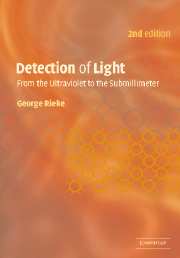Book contents
- Frontmatter
- Contents
- Preface
- 1 Introduction
- 2 Intrinsic photoconductors
- 3 Extrinsic photoconductors
- 4 Photodiodes and other junction-based detectors
- 5 Amplifiers and readouts
- 6 Arrays
- 7 Photoemissive detectors
- 8 Photography
- 9 Bolometers and other thermal detectors
- 10 Visible and infrared coherent receivers
- 11 Submillimeter- and millimeter-wave heterodyne receivers
- 12 Summary
- Appendices
- References
- Index
7 - Photoemissive detectors
Published online by Cambridge University Press: 09 November 2009
- Frontmatter
- Contents
- Preface
- 1 Introduction
- 2 Intrinsic photoconductors
- 3 Extrinsic photoconductors
- 4 Photodiodes and other junction-based detectors
- 5 Amplifiers and readouts
- 6 Arrays
- 7 Photoemissive detectors
- 8 Photography
- 9 Bolometers and other thermal detectors
- 10 Visible and infrared coherent receivers
- 11 Submillimeter- and millimeter-wave heterodyne receivers
- 12 Summary
- Appendices
- References
- Index
Summary
Photoemission refers to a process in which the absorption of a photon by a sample of material results in ejection of an electron. If the electron can be captured, this process can be used to detect light. Photoemissive detectors use electric or magnetic fields or both to accelerate the ejected electron into an amplifier. At the amplifier output, the photon stream can be detected as a current or even as an individual particle. These detectors are capable of very high time resolution (up to 10-9 s) even with sensitive areas several centimeters in diameter. They can also provide excellent spatial resolution either with electronic readouts or by displaying amplified versions of the input light pattern on their output screens. They have moderately good quantum efficiencies of 10–40% in the visible and near infrared; in some cases, significantly higher values apply in the ultraviolet. They are unmatched in sensitivity at room temperature or with modest cooling, leading to many important applications. In addition, they provide unequalled performance in the ultraviolet. They can be readily manufactured with 106 or more pixels. If the photon arrival rate is low enough that they can distinguish individual photons, the detectors are extremely linear.
General description
A photoemissive detector is basically a vacuum tube analog of a photodiode; in fact, the simplest form of such a detector is a vacuum photodiode, illustrated in Figure 7.1.
- Type
- Chapter
- Information
- Detection of LightFrom the Ultraviolet to the Submillimeter, pp. 187 - 216Publisher: Cambridge University PressPrint publication year: 2002



